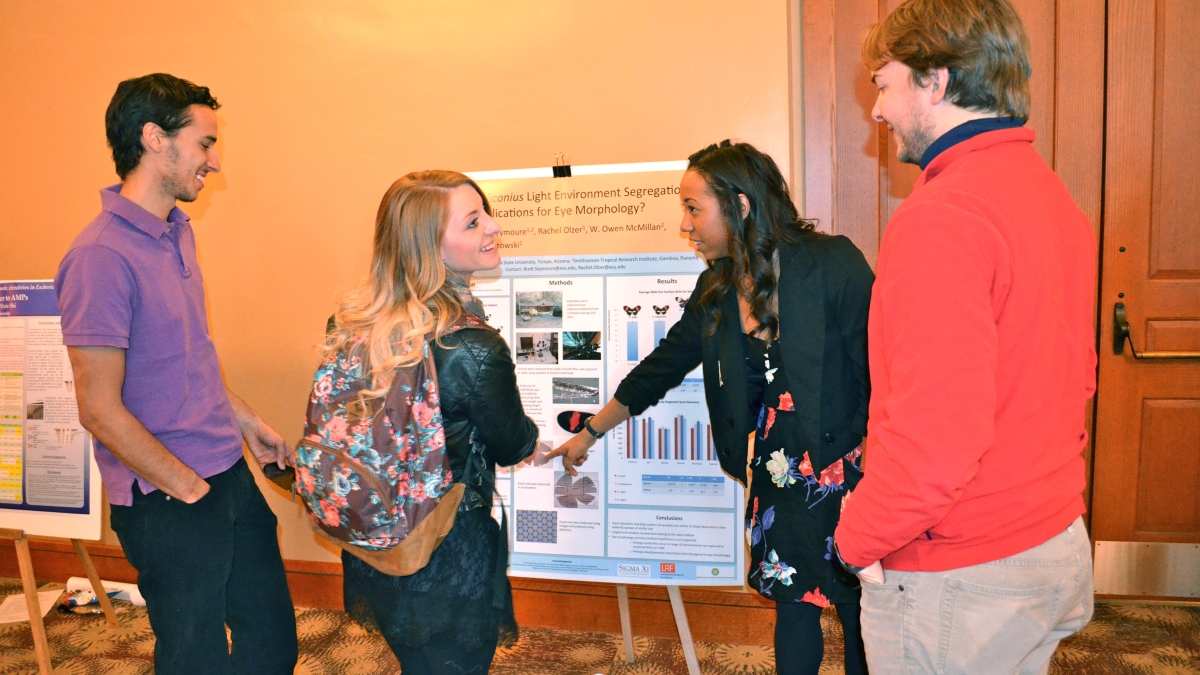Program to support underrepresented students interested in scientific research

Undergraduate and graduate students at Arizona State University interested in biomedical and behavioral research now have comprehensive support from a new program aimed at helping them reach their academic goals.
Called “Graduate and Undergraduate Training in Biomedicine at ASU,” the program is part of the Initiative for Maximizing Student Development (IMSD) – a training program funded by the National Institutes of Health (NIH) and designed to support underrepresented students as they pursue degrees in biomedical and behavioral research.
ASU’s School of Life Sciences officially launched the university’s IMSD program on Jan. 14 with a ceremony and poster presentations highlighting research conducted by undergraduate and graduate students. Students from the University of Arizona and Northern Arizona University IMSD programs also presented research projects.
Each university's IMSD program addresses challenges faced by students from underrepresented groups. These students are traditionally identified as those with African-American, Native American, Native Hawaiian, Hispanic and Pacific Islands heritage. For students conducting independent research, the program provides individualized faculty mentorship and facilitates student transition from undergraduate studies to doctoral programs. As students move through the program, they participate in activities such as peer mentoring, summer workshops and seminars that build skills in science writing, critical thinking and quantitative methods.
Stuart Newfeld, IMSD program director and professor in the School of Life Sciences, says the training is specialized and competitive.
“This program provides financial and academic support for two years of research by undergraduates and graduate students and is designed to fit ASU’s student body,” says Newfeld. “We have 15 undergraduate slots and five for graduate students. What makes the ASU IMSD program unique is that it reaches beyond traditionally defined underrepresented students to those with disabilities and financial disadvantage.”
The National Institutes of Health sets high expectations for IMSD programs. The medical research agency expects 60 percent or more of IMSD undergraduates to enter graduate school in a biomedical or behavioral field (not medical or dental school) immediately upon graduation. It also expects 90 percent of graduate students in the program to earn their doctoral degrees within six years and then continue to earn a professional research position in an academic or industry setting.
School of Life Sciences sophomore Ryan Muller volunteered to help with the IMSD launch and present his scientific poster. He is part of an undergraduate research team developing a biosensor that can detect the DNA of pathogenic substances in water. Muller is a dual major in medicinal biochemistry and molecular biology and biotechnology.
“I like how the IMSD program facilitates getting involved in research and makes this excellent opportunity more accessible to other students, especially those in minority groups,” says Muller. After earning his undergraduate degree, he plans to pursue a doctoral degree in biological engineering and hopes to become a professor and run his own research lab.
Natasha Weatherspoon-Griffin, a School of Life Sciences doctoral candidate in the molecular and cellular biology graduate program, also presented her project. Her research focuses on the genetic basis for Salmonella and E. Coli resistance to antimicrobial peptides. She explains that these peptides are promising candidates for alternatives to antibiotics.
“I was excited to have funding and the opportunity to get my research out there and help other underrepresented students in the sciences. The IMSD program sounded like a great idea,” she says.
Undergraduate students encouraged to apply
ASU’s IMSD program has several openings for undergraduate participants. Students interested in life sciences, natural or physical sciences or behavioral fields such as psychology and nursing, from any of the four ASU campuses, must submit an application by Feb. 15.
Applications include a statement of interest, a current resume, a letter of recommendation from a current research mentor (if applicable) and unofficial transcripts. If students are interested in biomedical or behavioral research but not currently working in a lab and they meet the other criteria (for example, they are underrepresented and have a GPA above 3.0), then the IMSD program will help them find a mentor. Students will be informed of their selection around March 15 and may begin research May 15.
The National Institute of General Medical Science (NIGMS) of the National Institutes of Health (NIH) funds IMSD.
For more information and application forms visit http://imsd.asu.edu. For questions contact Kristina Valenzuela, IMSD project coordinator at imsd@asu.edu, or (480) 965-7498.
The School of Life Sciences is an academic unit of the College of Liberal Arts and Sciences.
Editorial contributor: Gabi Malo